ARTIFICIAL IMPROVISATION
It's Here & Now
(part-002/003)
WELCOME to PART 2 of the AI IMPRO special!!!
If you got to the end of PART 1, you would have realised that 70% of it was co-written by AI (including 4 of the 6 pictures which were AI generated.)
I promise not to do that again. Or am I doing it now!!!??? Damn you AI!!!
Let’s take a look at some possible formats and at some actual formats being played with AI in front of audiences around the world.
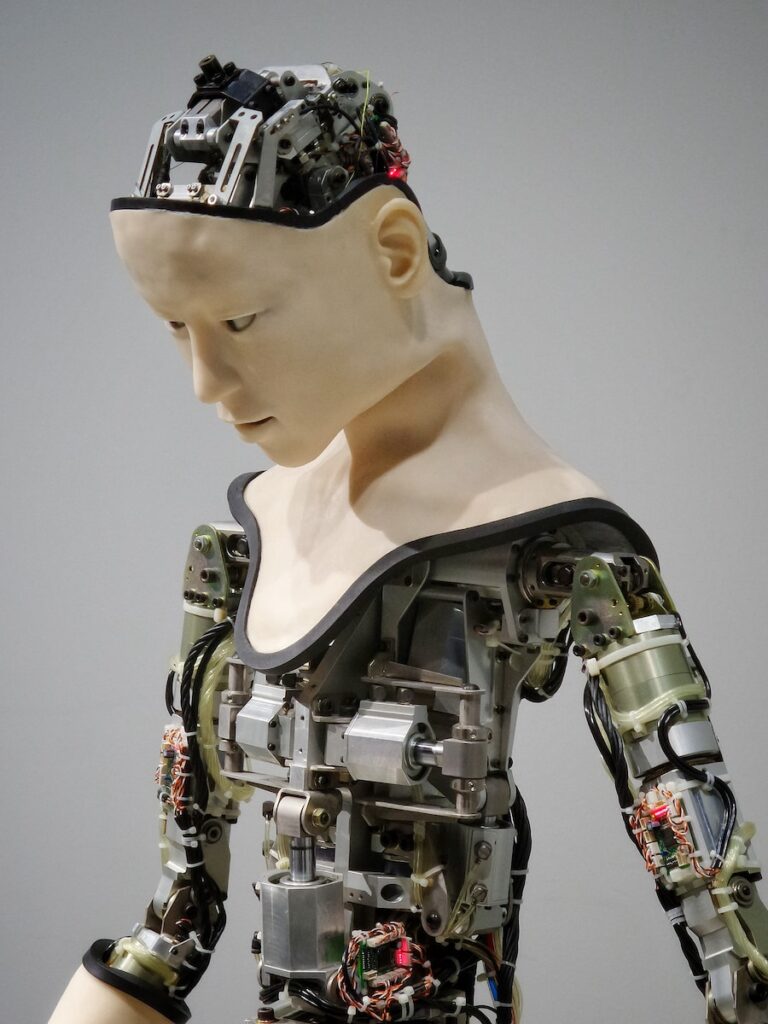
POSSIBILITIES ARE ENDLESS
When I stumbled through my first conversation with AI (Chat GPT) 2 months ago and failed to trip it up with my challenges to create ever-increasingly complicated and detailed stories, I started thinking about potential AI uses and formats on the impro stage.
(Sidenote… one of the following formats was generated by AI. Can you figure out which one?)
- MAN VS MACHINE —- AI creates a story based on an audience suggestion which is read aloud to the audience. The performers are challenged to perform a scene BETTER based on the same suggestion. The audience chooses which they like more. The evening is a battle of AI over the humans. WHO WILL REIGN THE IMPRO STAGE WHEN THE POINTS ARE TABULATED?!?!?
- IMPROVISED TURING —— Some performers wear earpieces and perform scenes based on AI suggestions and instructions. Other performers improvise scenes as usual with the inspiration of their partners and human-generated inspiration.
Audiences attempt to discover what was human and what was machine, much like the famous 1950 TURING TEST aimed at challenging a machine’s ability to exhibit human ‘quality’ communication. - GPT OR NOT!?? (That is the Question!) Two teams of improvisers are sitting on opposite sides of the stage. Each team has a monitor in front of them. The MC of the show asks the audience where they’d like to see a scene take place, or what theme the scene is about. Someone in the booth relays the AI suggestion to ONE TEAM.
ONLY ONE TEAM will get the AI inspirations and MUST incorporate the suggestions into their work. The other team can use audience suggestions or their own inspiration. At the end of both scenes, the audience is asked which team did the better scene.
The better scene gets a point. THEN the audience is asked if the scene was human or AI inspired. If they are correct, the AUDIENCE gets a bonus point. Is the audience smart enough to know human from computer, and who do they prefer???
- CAN YOU TELL —– Before the show, Improvisers mingle with the audience and get suggestions for stories that they would like to see on stage. At the same time some of the cast and crew are generating suggestions from AI on a computer at the side of the stage. The suggestions are mixed into a bowl. Throughout the show, Improvisers pull suggestions and do scenes based on what is read. The audience is challenged to discover what was inspired by their ideas and what AI inspired.
It’s the wild west of possibilities where AI is concerned. And the possibilities are limitless. If you are interested in which format was AI-generated, head to the end of this article!
FROM THOUGHT TO REALITY
Of course, I’m not the only one in the process of playing with this crazy TOY.
When the pandemic rolled over us all, we were imposed with the reality of exploring IMPRO online. The end result wasn’t universally inspiring but there were a few experiments that opened the doors for developing a better way of improvising in that bubble.
With AI, nobody is forced to explore the possibilities of the new reality but those that do it, are doing it out of passion and curiosity. Some of the work is like those initial online ZOOM experiments. They are the first stepping stones towards whatever the future will be.
IMPROBOTICS
Groups like IMPROBOTICS have mixed international improvisers into the sea of exploration and they’ve gone further than most having been involved in one way or another since 2015.
As I watched the Improbotics with their explorations, I saw in one clip where they performed one of the formats that I hypothesized above. (TURING IMPRO) I hadn’t seen their work at the time of writing that section. I’m sure others have gone down that obvious path as well.
This interesting combination and connection and convergence of ideas in the realm of possibilities is what we and AI have in common. AI, after all, is just a massive sampling of what we’ve been saying and doing and documenting for the past few thousand years. For the people who dismiss AI as a distant robotic entity, realise that AI is just we human ideas, mashed into an expression filtered through a CPU brain
From the Improbotics, I asked a few questions about their explorations.
What is IMPROBOTICS?
Improbotics (https://improbotics.org) is a science improv theatre company. In our shows, human actors perform with physical robots, artificial intelligence chatbots and augmented or virtual reality. The premise of our shows is to demonstrate how human actors can perform to the top of their intelligence and of their emotional expression when challenged but also empowered by technology. Improv can be seen as walking a tightrope (with the support of an enthusiastic and supportive audience); in our case, we make the tightrope longer and more wobbly, but also so much more fun.
At the same time, we explore how human actors can be inspired by technology tools to co-create something new and beautiful. For instance, Improbotics can be seen as an acting training technique. In one of our show formats, the actors get lines generated by the AI into their ears. That means they do not have to think about what to say next, and instead, focus on their stage partner and on the reality of the scene, knowing that an AI will give them the words to say.
What inspired you to do it?
Dr. Piotr Mirowski and Dr. Kory Mathewson, two researchers in AI who are also improv and theatre actors, had in 2015 a strange idea of bringing a robot on the stage and to improvise comedy with it. They met online and started doing shows in 2016. Initially, the show consisted only of one or two human actors interacting with a robot. Piotr had coded up the chatbot from scratch and trained a neural network on the dialogue from 100 thousand films – it took one month for the AI to be trained on all that data.
The robot had three obvious problems: it lacked timing, emotions and physicality. So in 2018, Piotr and Kory realised that the only way to solve that problem was to give the robot lines to human actors. That’s how Improbotics started, in London (where Piotr lives), in Canada (where Kory lives) and in Stockholm, (where Jenny Elfving, a friend who is passionate about the project, lives) and three human theatre troupes were created in these three cities.
About a year later, Ben Verhoeven from Belgium – also with a double background being a professional improviser with a PhD in computational linguistics – joined as a fourth artistic director premiering Improbotics in Belgium in early 2020.
Altogether, close to 100 actors have been part of the 4 troupes, or improvised in the show as guests, in a multinational cast of professional actors, improvisers and comedians.
During the pandemic, we shifted our practice online. This where Dr. Boyd Branch, a Fulbright fellow and directs the Improvisational Media and Performance Lab at Coventry University, had a beautiful idea of the London, Stockholm, Montréal and Antwerp-based troupes: tele-immersive improvisation. Boyd developed a simple immersive rehearsal space that only required green screens but that was much better than the typical Zoom improv setting where everyone is in a box.
In the London troupe, Sarah Davies, a lecturer in drama at University of London, explores the potentials of AI to inspire improv actors and to create grounded, connected improv.
Is it something you want to explore further or do you think it’s a gimmick that will fade?
We do not take it as a gimmick at all. Improbotics inspired Kory Mathewson to shift his PhD thesis at the University of Alberta, from robotics to human-computer interaction. It has shifted Piotr Mirowski’s research towards the ethics of human-computer interaction. We have published over 15 research papers about Improbotics, about the imitation game, about absurdism, about improv with live translation or tele-immersive improv. We have presented Improbotics at the Global Initiative Improvisation Symposium in 2019. We have build collaborations with many improv troupes and theatre companies around the world, like Dr Gunter Loesel’s own project on chatbots on stage. We want to build bridges between multiple disciplines, theatre and science!
What is the show?
The main current format of the show is human actors interacting with a chatbot powered by AI. Certain actors on stage are fed lines by the AI (and can only say those AI-generated lines) while other improvisers strive to justify them, resulting in a hilariously absurd comedy. We typically conclude the show with a Turing test where the audience needs to guess who is the Cyborg. We inspire audiences to reflect about human creativity and to share the joy of messing with robots.
The typical build-up of our show explores how a robot can best perform improvised theatre. To start off, we have a scene between a human actor and a robot actor showing how this machine performs without much human help. The next step is giving our chatbot a human body. This Cyborg then performs in a few scenes together with human improvisers. Towards the end of the show we perform a Turing test in which the audience gets to uncover which of the actors on stage was controlled by the chatbot. Throughout the show, some bits and pieces of info about artificial intelligence and chatbots are shared with the audience.
How was the process rehearsing it?
It is a continuous experimentation with the cast and the developers! At the same time, we are trying to build a show that works well and that is well received and funny, and so most of the work is focused on improv, while Piotr, Kory, Boyd, Thomas Winters, etc. work on the tech.
Is the show evolving as fast as AI?
Over the years, we spent several thousands of hours of programming and technology development in the show, and we saw how the technology shifts and how we adapt to new possibilities.
Piotr and Kory started performing the improv Turing test on stage at the Edinburgh International Festival in 2017 and they noticed that the audience easily guessed when it was a chatbot or not. The language technology that they used was less advanced than today. When they started Improbotics in 2018, the actors learned how to speak like a robot (or to say nonsense) and to deceive the audience, so the Cyborg passed the Turing test because of the wrong reason. Today, when we use state-of-the-art language technology like GPT-3 or even GPT-4, and what the Cyborg says “makes sense”. The other actors no longer need to pretend they are robots for the Cyborg to pass the Turing test, and the audience guesses right only half of the time.
One element that we added to the show is rapid image generation using Stable Diffusion, and rapid response and inspiration to what the images are presented.
How is the audience receiving it?
Since 2016, we have performed various versions of the show about 200 times, in over 10 different countries. The audiences love it! The show happened in a variety of places, including theatres such as the Rapid Fire Theatre (2018-2019), Gilded Balloon at Edinburgh Fringe 2023, the Attenborough Arts Centre (Leicester Comedy Festival 2022), The Cockpit Theatre (Camden Fringe 2021), The Warren (Brighton Fringe 2021 and 2019), Rotunda Theatre (Brighton Fringe 2022 and 2023), The Scottish Storytelling Centre (Edinburgh International Improv Festival 2020), The Rich Mix (Voilà ! Europe Festival 2019), international improv festivals in Amsterdam, Göteborg, Würzburg, as well as museums.
Our shows have been featured on BBC Click, in the New York Times, Wall Street Journal, New Scientist, Time Magazine, ABC Australia, Bloomberg, CA News Canada, and we have received many positive reviews: “Groundbreaking work”, “high quality comedy theatre”, “raises important philosophical questions” (Fringe Review 2022), ★★★★ (Binge Fringe 2020), Most Innovative Show Award (Online Paris Fringe 2020), ★★★★★ (Phoenix Remix 2019), ★★★★ (Edmonton Fringe 2018), “This could be revolutionary” (Broadway Baby), “Had I seen such a show as a kid, I would have paid more attention to science class” (Phoenix Remix).
What limitations do you think it has?
Our imagination.
What are the strengths? Memorable moments (good and bad).
We had this absolutely terrible show in 2017, where nothing worked. The reviewer came that night and wrote: 2 stars. Chaotic. “Never work with robots”. We did not listen and the rest is history!
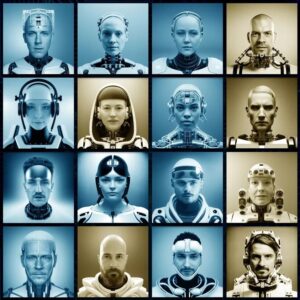 Humans of IMPROBOTICS include:
Humans of IMPROBOTICS include:
- Kory Mathewson
- Piotr Mirowski
- Ben Verhoeven
- Sarah Davies
- Jenny Elfving and
- Boyd Branch
ROBOT of IMPROBOTICS:
- A.L.Ex, (which stands for Artificial Language Experiment. Its pronouns are it/its.)
TEENS TAKE ON AI
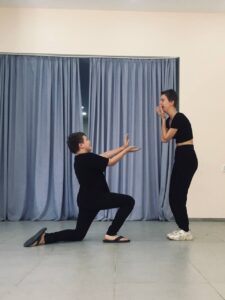 As Piotr from Improbotics aptly mentions, the limitations of exploration is limited only by human imagination. As I started writing this article, Tim Tkachev, theatre director & teacher based in Tbilisi, Georgia, and co-founder of international art Group 1212 dropped me a message to tell me about their own AI exploration:
As Piotr from Improbotics aptly mentions, the limitations of exploration is limited only by human imagination. As I started writing this article, Tim Tkachev, theatre director & teacher based in Tbilisi, Georgia, and co-founder of international art Group 1212 dropped me a message to tell me about their own AI exploration:
“We’re developing it (AI format) now together with a group of teenagers. Here’s how it works:
- a) split the actors in teams by 2-3 people
- b) each team makes up a start sentence for each other.
Eg. team A writes for team B: “The monkey was too fat to get the banana so it preferred to starve.” Team B writes for team A …- c) each sentence is uploaded to AI with the request to continue the story
- d) each team has 1-3min to stage the text that they received (and, of course, transform it in an impro way). Eg. team B will play the story about the monkey + whatever the AI added there + whatever they add themselves right on stage.
It is possible to give no preparational time for the actors to add more impro of course.One of the main educational messages of this game is that AI can’t make it alone, it’s just a robot. So the texts it makes always lack or sense, or humor, or (always) humanity. And people always need to interpret, adjust or remake the things the AI wrote. I kinda demonstrate that robots cannot control us hahaha.The practical message is, of course, impro: they don’t have enough time to prepare so they need to improvise.

“The day my computer thought, it had more personality than me”
Last month I visited the German improvisation group YES ODER NIE to work on a Keith Johnstone project. On the walk from the theatre with Lorenz Fischer we chatted about “an interesting side project” he was involved with.
Lorenz is a cast member of “The day my computer thought, it had more personality than me”. Lorenz and Gunter Lösel tell me a little bit about their recent AI exploration.
The show premiered on Feb 25th in Dresden, Germany and is part of a series of artistic experiments involving AI in improvisation.
The audience was led through the performance by an AI incorporated into a bottle – kind of like a genie in a bottle. The aim of the locked-up AI was to inhabit the bodies of the actors and in a second step to be freed out of the bottle. For this, it had to convince a volunteer from the audience to open the bottle.
The performance originated from a research project called “the answering machine” led by 4 universities (Zürich, Dresden, Stuttgart, Tübingen) and involved Gunter Lösel, Nicole Erichsen, Mirko Fichtner, Marcus König, Lorenz Fischer and Ralf Priemer.
During rehearsals we had to find out, which AI machines worked and didn’t work for our purposes – we experimented with AIs with different personality traits and with generative AIs.
We also had to find something like a basic narrative to hold the show together (there were several independent scenes using different technologies throughout the evening that were held together by the main plot). For the players it was a fun experience that came with unusual improv-related challenges, as the answers of the machines were often out of the frame of expectation. But once you got an idea of how the machine thought, you could even use their logic “against” them (We tricked a prison guard AI into helping us escape).
For the audience it seemed to work really well and there were a lot of lively discussions about the topic of AI after the show.
We plan to devise three more shows around the topic of human machine interaction in the next three years. Also, we will present the first version several times throughout the next year (in Switzerland and Germany).
The first inspiration for the show came from a performance from Improbotics that we saw. After that we really wanted to know how far this could go. Gunter and The Stupid Lovers created a first show called “Almost Human”, featuring two AIs in 2019. After that we succeeded in raising money for a four year artistic research project.
The first year is over now.
We think that within impro AI might not be prevalent permanently in the long run, but at the moment it seems the thing to do, as AI affects almost every part of life and people really want to understand and discuss this topic.
AI generated Image for their show – Lorenz Fisher Gunter Lösel
There also seems to be an inner relationship between impro and AI, as it is all about finding the next move, the next word, the next thing to do – so that by interacting with AI one might even learn about his/her own operating mode.
On a technical side, the latency in the machine responses are still a hassle for a live performance. We had to introduce some workarounds to cover them up.
The strength lay in really creating the illusion of an AI being present in the room. There was also a strong experience of the AI following its own logic throughout the play, which challenged the actors to new approaches to improvisation.
One memorable moment was, when the volunteering person from the audience had to choose, whether to open the bottle and set the AI free or leave it shut. After a conversation with the AI the volunteer said “I am not convinced, but I want to know what is going to happen – so I will free it anyway…”
AI or Not 2A!
It’s obvious that the spirit of the improvisers will define the success of these AI experiments, just as it defines the success of any improvised show, with its built-in failures and successes.
When the veil around the machine eventually drops and we see that the magic pulling the strings is just human inspiration, audiences will tire of the computer-packaged presentation unless the shows have the spirit and attitude of real improvisers. It also helps if the stories are memorable.
We’ll see you next time for part 3 of AI IMPROVISERS!
And if you were looking for the answer posed at the beginning of this article, the ARTIFICIAL INTELLIGENCE GENERATED FORMAT WAS…
GPT OR NOT!??
—- —- —– —– — — – —— — – ——- – —– —- — —– – —-
This 3 part exploration looks at:
WHERE WE ARE NOW WITH AI AND IMPRO – PART 1
WHAT IMPROVISERS ARE DOING RIGHT NOW WITH AI – PART 2
MISTAKES, THREATS and PLEAS FOR SENTIENCE – WHERE THE FUTURE OF AI AND IMPRO IS HEADED – PART 3.
Feel free to send your thoughts (positive and negative) about AI in Impro.
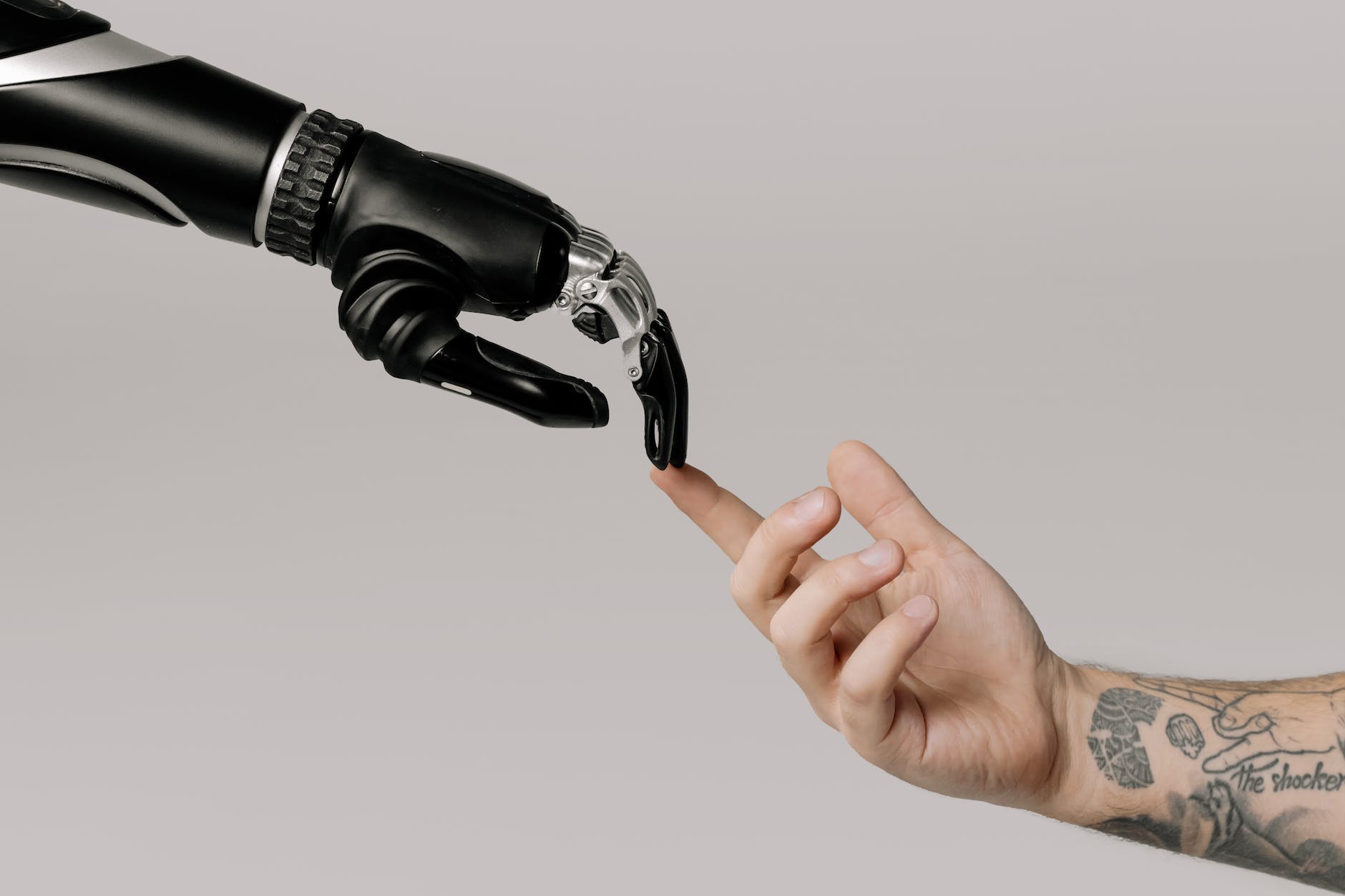

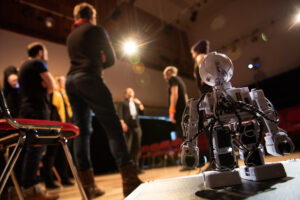




0 Comments